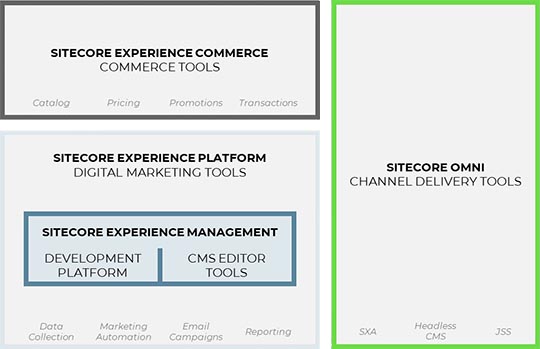If we take a look at the high-level architecture of the Sitecore platform with Experience Commerce in mind, we can split the components for a Sitecore platform below. I have left out other Sitecore offerings like Content Hub and Managed Cloud, as they are not relevant for the points I want to focus on in this article.
The element is split in four main areas. The split in areas are actually not completely true – but more emphasized to distinguish the roles of each.
The Sitecore Experience Management is the core tool for the developer and webstore merchandisers, where the editors create the content and the structure of the store and maintain this as well as delivers the core API and mechanisms for the developers to create the functionality and experiences of the webstore. Tools from the Sitecore Omni might be used for creating these – either through the headless approach of JSS or through the pre-built components of SXA. The Sitecore Experience Commerce gives the platform (editors as well as developers) the functionalities around completing commercial transactions – maintaining catalogs, prices, promotions etc.
The final piece in this is the Sitecore Experience Platform. My description of this part of the platform is that it drives the digital marketing capabilities of the platform – that being data collection, marketing automation tools as well as the analytics part of the platform.
THE THREE KEY ASPECTS OF E-COMMERCE TODAY
From an e-commerce perspective - driving your business through a Sitecore Experience Commerce platform offers you the ability to focus on the three important aspects of any modern e-commerce business.
- Content generation and targeting
- Transaction conversion
- Customer Loyalty optimization
The driver of ALL three aspects running on the Sitecore platform is DATA – driving the experience using the underlying data collection, action generation and experience driving concepts of the Sitecore Platform.
Content generation and targeting is all about making sure that you cross your marketing efforts have focus on the right content – but at the same time measuring the use and effectiveness of the content through the Experience Platform. Sitecore offers new capabilities in this area through the Content Hub – but that will be large a subject for this article – please stay tuned for more insights and opinions regarding this.
FROM FREE VISITOR TO PAYING CUSTOMER
The content generation and targeting are the classical Sitecore strengths of creating compelling content and through personalization as well as A/B testing target the content to relevant target groups.
The transaction conversion is focusing on any e-commerce managers most important KPI – measuring the effectiveness of changing free visitors to paying customers. The before-mentioned content targeting is one of the methods used – but also targeted promotions (use price reductions, free shipping and giveaways in the same manner as content) with a strong focus on creating actionable evidence of the effectiveness of specific promotional efforts. Often promotions are partly paid by other parties (suppliers, channel-partners etc.), so creating evidence of the effectiveness of promotions does not only give you knowledge in future campaigns, but also evidence that can be used to get funding for the next campaign.
From a Sitecore Experience perspective the overarching point is that the data evidence you collect creates actionable evidence – you can at a later point segment and target customers by the exact campaign that has driven previous behavior. Using the experience platform to do this – your conversion optimization effort gains the value of historic performance at the customer level. You might want to target a customer segment with only specific types of promotions, because data evidence has shown that the likelihood of it working is high. This is especially efficient, if you use more of the channel tools of Sitecore – EXM, Marketing Automation, JSS for App Integration as well as the classical web presence.
CREATE AS MUCH DATA KNOWLEDGE AS POSSIBLE
When you work with the Experience Platform for gaining actionable data insights it is important that you create as much data knowledge as possible in the process. This means you need to tag campaign links with Sitecore campaign tags (or map Google UTM tags) to get campaign insight, consider affiliate/referral registrations (to know which of your partners create value) as well as being knowledgeable about campaign groups, campaign facets and so on.
If you get this holistic tagging, you will be able to get a lot of insight into actionable data. We normally advise to start using A/B testing on specific segments identified through this data. It might be user targeted by a specific campaign and visiting the site more than 4 times before a purchase – these might be eligible for a free shipping discount on their third visit to see if we can start converting them quicker. It might also be that you A/B test two different voucher codes to the segment to see if free shipping is more efficient than 10$ off the order.
If you would like to discuss further on the data driven Experience Commerce – please get in contact with us.

KLAUS PETERSEN
Global CTO






